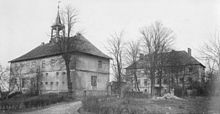Harburg Castle
The Harburg Castle on the castle island in the Harburg inland port is the oldest structural evidence of today's Hamburg district of Hamburg-Harburg and the origin of the Harburg settlement, which later became the city of Harburg / Elbe. The castle was destroyed several times in the course of its history, today only a structurally heavily modified side wing remains.
history
The castle was first mentioned in a document between 1133 and 1137 as Horeburg (castle in the swamp / moor). Findings of broken fragments suggest that they existed as early as the year 1000. The castle was built on a sand island in a swampy environment on today's Süderelbe, probably as a border fortress of the Counts of Stade .
At first glance, the building still preserved at this point does not suggest a castle or a formerly stately palace complex. The cellar vaults and parts of the outer walls, however, are probably from the 14th century . In 1527 the castle became the residence (until 1642) of the dukes of Braunschweig-Lüneburg , a branch of the Guelphs . They expanded it into a renaissance palace. Since 1620/1621 the complex consisted of three wings.
In 1644, during the Thirty Years' War , it was converted into a baroque fortress and the castle island was given its pentagonal star shape. For this, part of the houses, department store, scale and church of the city of Harburg had to be demolished. The town had developed on the connecting dam between the castle and the Geest from a settlement of castle men, craftsmen and others who were used to supply the castle. The outlines of this citadel are still partially preserved on the quayside of the castle island. In 1656, Henrick Ruse was commissioned by Christian Ludwig von Braunschweig-Lüneburg to renovate the fortress , designed by Percheval .
During the Seven Years' War the castle was besieged and shot at by French troops in 1757. In 1813, during the French occupation by Napoleon's troops, it was damaged again by fire.
After 1813 the parts of the complex that were still preserved at that time became the seat of the Harburg Office. In the middle of the 19th century, the Harburg port began to develop into an industrial port area. This is followed by the expansion of the harbor basin, partly including the castle moats. In 1898 the plant went to Reinhold F. Holtz and the castle shipyard he had previously taken over . The wing that still exists today was converted into a workers' house in 1900.
The monument protection registered in 1944 was lifted in 1950. In 1972 the east wing was demolished. In 1988 the rest was re-entered on the list of historical monuments.
Following the ongoing renovation of Harburg Castle, the establishment of a permanent exhibition on the history of the origins of the city of Harburg, as a branch of the Archaeological Museum Hamburg, is planned in the cellar vault of the former castle.
See also
The Bergedorf Castle is now the only fully preserved castle in the city of Hamburg.
Web links
- Pictures from Harburg Castle
- Initiative Harburger Schloss of the TU Hamburg-Harburg
- Historic postcard from Harburg Castle, ca.1900
- History of Harburg Castle in the Hamburger Abendblatt
- Reconstruction drawing by Wolfgang Braun
- The story of Harburg by Ralf Burger
- The Harburg Castle in the Harburg magazine
Literature and Sources
- Dehio: Handbook of German Art Monuments. Hamburg, Schleswig-Holstein. 2nd, greatly expanded and changed edition. Deutscher Kunstverlag, Munich et al. 1994, ISBN 3-422-03033-6 .
- Kottmeier, Johann-Christian: Building history of the Harburg palace . Hamburg 1994.
- Citadel plan. In: The port of Harburg with its immediate surroundings . Undated plan in the holdings of the Architekturmuseum der Technische Universität Berlin (to be classified using the railway lines after 1847 (opening of the Celle – Harburg line ) and before 1882 (opening of the Niederelbebahn ).
- Rüdiger Articus, Gorch von Blomberg, Tanja Gissel: The Harburg inland port . Ed .: Michael Merkel and Kay-Peter Suchowa (= publications of the Archaeological Museum Hamburg Helms-Museum . No. 109 ). Hamburg 2017, ISBN 978-3-931429-29-4 .
Individual evidence
- ^ Peter Hornberger: Foreword . In: Messages from the Museum and Heimatverein Harburg-Stadt und -Land e. V., Helms-Museum (Ed.): Helms-Museum Aktuell . No. 44 , March 2017, p. 1 .
Coordinates: 53 ° 28 ′ 11 ″ N , 9 ° 59 ′ 7 ″ E



